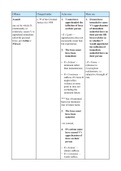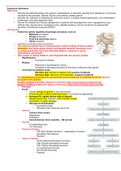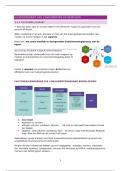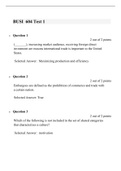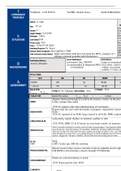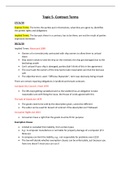,Perception/sensation
Senses
1. Touch - Mechanoreceptors
2. Hearing - Mechanoreceptors
3. Vision - Electromagnetic receptors
4. Smell - Chemoreceptors
5. Tase- Chemoreceptors
6. Self - Proprioreceptors/Mechanoreceptors
7. Temperature - Thermoreceptors
8. Pain - Nocireceptors
9. Balance - Mechanoreceptors
A neuron
Membrane potential difference between charge inside (-) and outside (+) the cell membrane (70 mV)
A change in potential of the receptor membrane is called the receptor potential. A receptor potential
above a threshold (-40 mV) is called action potential.
Skin
Basic mechanisms of action of sensory receptors
Pacinian corpuscle, layer of flexible membrane and a neuron which enters this. It has a large receptive
field with vague borders. It is a mechanoreceptor. Tactile stimuli on the Pacinian corpuscle gives
compression on the outer layers of the receptor body. It indents, but also indents and stretches the
membrane of the axon in it. Deformation of the axon membrane opens Na-channels.
It can only measure decrease/increase of pressure, if the pressure is constant there will not be an
receptor potential. The relation between the stimulus strength and receptor potential is not linear. The
receptor potential rises fast with increasing low stimulus strength, but progressively less with
increasing high stimulus strength. The receptor is a non-linear transducer.
The receptor potential and action potential is linear. The frequency of action potentials in the nerve
fiber (impulse rate) is directly proportional to the amplitude of the receptor potential. Action potential
is a linear transducer.
From stimulus to action potential
Equal pressure: Adaptation, eventually you do not notice anymore (f.e. clothes)
Increasing pressure: Saturation, eventually leads to damage
Sinusoidal pressure: Uneven pressure (waves), this is the most common (f.e. waving)
Receptors can follow the stimulus quite well within a certain trajectory. There are borders. Too low
stimulus: no reaction too high stimulus: saturation. Some receptors adapt fast, others slow.
, The transduction of sensory stimuli into nerve impulses is always by a change in potential of the
receptor membrane (receptor potential)
Receptor potentials are induced by:
- Mechanical deformation of the receptor
- Applying chemicals to the membrane
- Tempature change of the membrane
- Electromagnetic radiation on the membrane
If the receptor potential rises above the threshold to elict action potentials in the
nerve attached to the receptor, action potentials will start to appear.
Action potential
A traveling wave, entry of positive charge during the action potential causes the
membrane just ahead to depolarize. Channels will open when an action potential
comes along, and close again this causes the action potential to pass one
direction. This also causes the refractory period.
Two different somatosensory pathway
There are two pathways
Dorsal column-medial lemniscal pathway - goes via the dorsal nuclei
Spinothalamic pathway - goes directly to the thalamus
Labeled line principle
We have different types (modalities) of sensation. However, the nerves transmit only action
potentials. The action potential does not carry information about the modality. The brain areas the
nerves are connected to are responsible for the modalities.
Senses
1. Touch - Mechanoreceptors
2. Hearing - Mechanoreceptors
3. Vision - Electromagnetic receptors
4. Smell - Chemoreceptors
5. Tase- Chemoreceptors
6. Self - Proprioreceptors/Mechanoreceptors
7. Temperature - Thermoreceptors
8. Pain - Nocireceptors
9. Balance - Mechanoreceptors
A neuron
Membrane potential difference between charge inside (-) and outside (+) the cell membrane (70 mV)
A change in potential of the receptor membrane is called the receptor potential. A receptor potential
above a threshold (-40 mV) is called action potential.
Skin
Basic mechanisms of action of sensory receptors
Pacinian corpuscle, layer of flexible membrane and a neuron which enters this. It has a large receptive
field with vague borders. It is a mechanoreceptor. Tactile stimuli on the Pacinian corpuscle gives
compression on the outer layers of the receptor body. It indents, but also indents and stretches the
membrane of the axon in it. Deformation of the axon membrane opens Na-channels.
It can only measure decrease/increase of pressure, if the pressure is constant there will not be an
receptor potential. The relation between the stimulus strength and receptor potential is not linear. The
receptor potential rises fast with increasing low stimulus strength, but progressively less with
increasing high stimulus strength. The receptor is a non-linear transducer.
The receptor potential and action potential is linear. The frequency of action potentials in the nerve
fiber (impulse rate) is directly proportional to the amplitude of the receptor potential. Action potential
is a linear transducer.
From stimulus to action potential
Equal pressure: Adaptation, eventually you do not notice anymore (f.e. clothes)
Increasing pressure: Saturation, eventually leads to damage
Sinusoidal pressure: Uneven pressure (waves), this is the most common (f.e. waving)
Receptors can follow the stimulus quite well within a certain trajectory. There are borders. Too low
stimulus: no reaction too high stimulus: saturation. Some receptors adapt fast, others slow.
, The transduction of sensory stimuli into nerve impulses is always by a change in potential of the
receptor membrane (receptor potential)
Receptor potentials are induced by:
- Mechanical deformation of the receptor
- Applying chemicals to the membrane
- Tempature change of the membrane
- Electromagnetic radiation on the membrane
If the receptor potential rises above the threshold to elict action potentials in the
nerve attached to the receptor, action potentials will start to appear.
Action potential
A traveling wave, entry of positive charge during the action potential causes the
membrane just ahead to depolarize. Channels will open when an action potential
comes along, and close again this causes the action potential to pass one
direction. This also causes the refractory period.
Two different somatosensory pathway
There are two pathways
Dorsal column-medial lemniscal pathway - goes via the dorsal nuclei
Spinothalamic pathway - goes directly to the thalamus
Labeled line principle
We have different types (modalities) of sensation. However, the nerves transmit only action
potentials. The action potential does not carry information about the modality. The brain areas the
nerves are connected to are responsible for the modalities.


